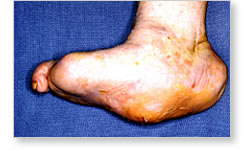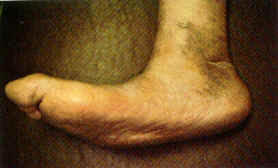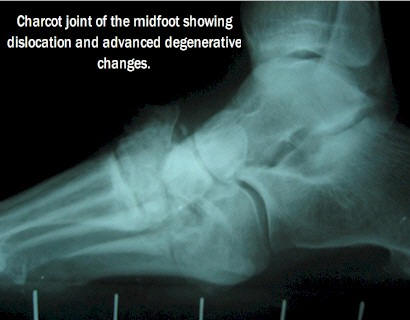

Charcot Foot
Synopsis
Charcot Foot is a pattern of bone and joint destruction that can lead to severe foot deformities. This disease usually begins with peripheral neuropathy (decreased feeling in the feet) and decreased blood circulation, most commonly seen in diabetics. People with decreased nerve sensation may injure their feet, producing small fractures in the bones; and because they have decreased feeling, they may have minimal or no pain, and they continue walking on the foot. This combined with the lack of ability to heal by having limited circulation weakens the supporting structures of the foot and eventually result in the deformity.
|
|
|
Diagnosis and Treatment
The acute, or
early symptoms of Charcot Foot are: small fractures of the bones of the foot,
swelling over these areas, and later the entire foot may become swollen and
inflamed. There is little, if any pain during this stage. Treatment during this
stage is imperative, and includes: complete rest of the foot by using a non-weightbearing
cast, crutches, and bed rest. If treatment is not initiated, this disease
progresses to its chronic stage. During this stage the following symptoms may be
present: a foot which is deformed, and noticeably different then the other foot;
a collapsed arch; bones which abnormally protrude against the skin, possibly
causing the skin to breakdown and ulcerate; swelling and inflammation of the
foot; and there may be no pain present, or in some patients the pain is intense,
due to the amount of bone and joint destruction present.

Treatment depends on the severity of the bone deformity at the
time of diagnosis. Some cases require surgery immediately and others can be
treated in a boot. The use of a boot or cast is important and no weight should
be put on the foot until healing occurs. It can take up to a year for the bone
to heal and the boot may have to be worn during this healing phase. At later
stages it may be possible to put patients into an Ankle Foot Orthosis as well as
custom diabetic shoes with rigid rocker soles.
Preventative Measures
Anyone who has
peripheral neuropathy, especially diabetics, should be treated with custom
molded orthotics to help guard the feet against injuries; to support the bones
and joints of the feet, thus preventing deformities from occurring; and to
protect the bottom of the feet from friction, calluses, and ulcers of the skin.
Examine your feet daily including the tops, bottoms, and between your toes. Look
for inflamed areas, cuts, peeling and breaks in the skin, rashes, and swelling.
Wear properly fitted supportive shoes with the toe box (the area where the toes
lie in the shoe) being deep and wide to reduce pressure on the toes, the heels
should be no higher than 3/4 inch. Rocker profile of the forefoot helps.
Seamless socks and shoes cause less problems then those with seams. Always wear
shoes and socks; they protect the feet from injury. Do not walk barefoot.